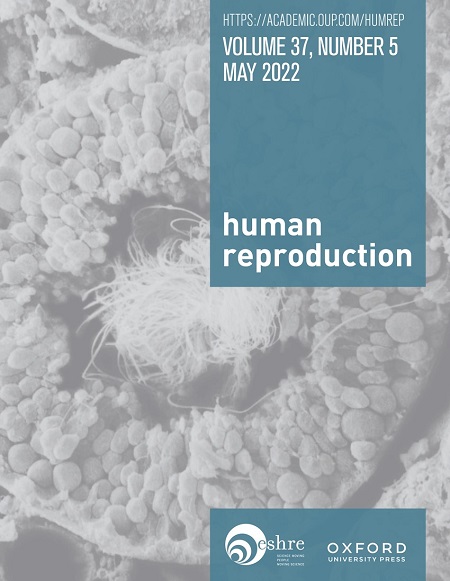From hope to hesitation: why couples fail to return for infertility treatment after the first consultation
IF 6
1区 医学
Q1 OBSTETRICS & GYNECOLOGY
引用次数: 0
Abstract
STUDY QUESTION What are the key factors that influence couples’ decision not to return for fertility treatment after their first consultation? SUMMARY ANSWER Advanced maternal age, lower ovarian reserve, and eligibility for heterologous fertilization are primary determinants of non-return among couples. WHAT IS KNOWN ALREADY Previous research highlights the psychological, financial, and demographic reasons behind high dropout rates in IVF, yet a comprehensive understanding of the factors driving non-return, particularly at the first consultation, is still lacking and warrants further study. STUDY DESIGN, SIZE, DURATION This single-center observational study, incorporating both retrospective and prospective components, analyzed couples consulting at Humanitas Research Hospital from 2012 to 2021. The retrospective review spanned 24 773 couples from 2012 to 2021, among whom 6174 did not return. The prospective cohort included 986 couples who failed to return out of a total of 3214 couples who had their first consultation in 2021. PARTICIPANTS/MATERIALS, SETTING, METHODS Participants included couples seeking their first fertility consultation at a specialized fertility center. Retrospective data were extracted from internal records to assess personal, demographic, and biological factors (anti-Mullerian hormone [AMH] and FSH levels) contributing to non-return, while non-returning patients in the prospective arm completed a telephone questionnaire in addition to data extraction from internal records. MAIN RESULTS AND THE ROLE OF CHANCE Between 2012 and 2021, 24.92% of couples did not return after the initial consultation, with older age and diminished ovarian reserve as significant predictors. Of 3214 couples in 2021, 986 (30.68%) did not return after their first consultation. All 986 patients were contacted, and the response rate was 85.1%. Non-returning women were significantly older (37.1 vs. 35.6 years) and exhibited lower AMH levels (1.87 vs. 2.83 ng/ml) and higher FSH levels (13.13 vs. 8.19 mIU/ml). Primary reasons for non-return included eligibility for gamete donation (34.09%), spontaneous pregnancy (29.20%), and transferring treatment to another center (18.71%). Other contributing factors were existing parenthood (11.43%), psychological distress (9.65%), and dissatisfaction with the doctor (7.39%). These findings highlight the multifaceted nature of treatment discontinuation and underscore the importance of comprehensive support to mitigate non-return risk. LIMITATIONS, REASONS FOR CAUTION This study is limited by its single-center design: generalizability may vary based on differences in patient demographics and healthcare settings across regions and countries. Additionally, the prospective analysis may be affected by selection bias, as those non-returning patients who could not be reached might have provided meaningfully different answers. WIDER IMPLICATIONS OF THE FINDINGS These findings align with current literature while providing new insights into non-return for fertility treatment. The study underscores the need for tailored support and counseling to address the challenges faced by the couples, potentially enhancing treatment adherence and outcomes. STUDY FUNDING/COMPETING INTEREST(S) This research received no specific funding. The authors report no conflicts of interest. TRIAL REGISTRATION NUMBER clinicaltrials.gov NCT06344585.从希望到犹豫:为什么夫妇在第一次咨询后不能返回不孕症治疗
研究问题:在第一次咨询后,影响夫妇决定不返回生育治疗的关键因素是什么?高龄产妇、卵巢储备较低和是否适合异源受精是夫妻不生育的主要决定因素。先前的研究强调了体外受精高辍学率背后的心理、经济和人口原因,但对导致无回报的因素的全面了解,特别是在第一次咨询时,仍然缺乏,需要进一步研究。研究设计、规模、持续时间本单中心观察性研究纳入回顾性和前瞻性成分,分析了2012年至2021年在Humanitas Research Hospital进行的夫妻咨询。这项回顾性调查涵盖了2012年至2021年的24773对夫妇,其中6174对没有回家。该前瞻性队列包括在2021年首次进行咨询的3214对夫妇中,有986对未能返回。参与者/材料,环境,方法参与者包括在专业生育中心寻求第一次生育咨询的夫妇。从内部记录中提取回顾性数据,以评估导致不复发的个人、人口统计学和生物学因素(抗苗勒管激素[AMH]和FSH水平),而前瞻性组中不复发的患者除了从内部记录中提取数据外,还完成了电话问卷调查。在2012年至2021年期间,24.92%的夫妇在初次咨询后没有返回,年龄较大和卵巢储备减少是重要的预测因素。在2021年的3214对夫妇中,986对(30.68%)在第一次咨询后没有回来。986例患者全部接触,有效率85.1%。未回国的女性明显年龄较大(37.1对35.6岁),AMH水平较低(1.87对2.83 ng/ml), FSH水平较高(13.13对8.19 mIU/ml)。不返回的主要原因包括配子捐赠(34.09%)、自然妊娠(29.20%)和转移到其他中心治疗(18.71%)。其他影响因素为既有父母身份(11.43%)、心理困扰(9.65%)和对医生不满意(7.39%)。这些发现突出了治疗中断的多面性,并强调了综合支持对减轻无回报风险的重要性。本研究受到单中心设计的限制:泛化性可能因不同地区和国家的患者人口统计学和医疗环境的差异而有所不同。此外,前瞻性分析可能受到选择偏倚的影响,因为那些无法联系到的未返回的患者可能提供了有意义的不同答案。这些发现与目前的文献一致,同时为不育治疗的无回报提供了新的见解。该研究强调,需要量身定制的支持和咨询,以解决夫妇面临的挑战,潜在地提高治疗依从性和结果。研究资金/竞争利益本研究未获得特定资金。作者报告没有利益冲突。试验注册号:clinicaltrials.gov NCT06344585。
本文章由计算机程序翻译,如有差异,请以英文原文为准。
求助全文
约1分钟内获得全文
求助全文
来源期刊

Human reproduction
医学-妇产科学
CiteScore
10.90
自引率
6.60%
发文量
1369
审稿时长
1 months
期刊介绍:
Human Reproduction features full-length, peer-reviewed papers reporting original research, concise clinical case reports, as well as opinions and debates on topical issues.
Papers published cover the clinical science and medical aspects of reproductive physiology, pathology and endocrinology; including andrology, gonad function, gametogenesis, fertilization, embryo development, implantation, early pregnancy, genetics, genetic diagnosis, oncology, infectious disease, surgery, contraception, infertility treatment, psychology, ethics and social issues.
 求助内容:
求助内容: 应助结果提醒方式:
应助结果提醒方式:


